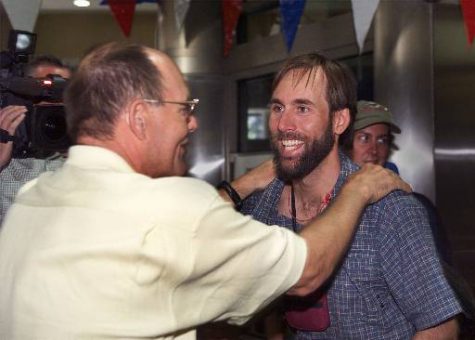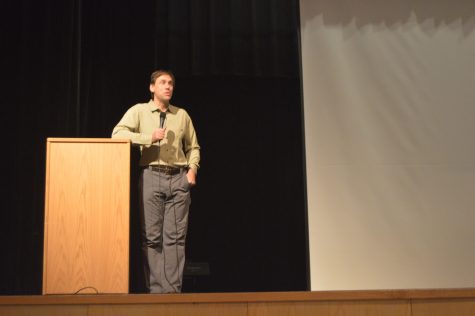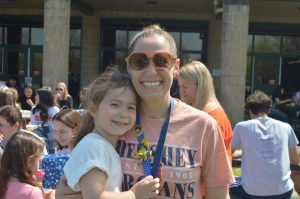First Blind Man to Climb Everest Comes to Hershey
February 16, 2017
He’s a certified sky diver, certified paraglider, ice climber, has climbed the 7 summits, including Everest, kayaked the Grand Canyon, published 3 books, been involved in 3 movies, and cofounded No Barriers USA. Erik Weihenmayer has accomplished of all this blind.
On February 10, 2017, Weihenmayer came to Hershey Middle School to speak to the Hershey community about his many accomplishments. Although Weihenmayer started losing his vision when he was just 13, he said he didn’t climb Everest or learn to kayak to prove blind people are capable. He said it was about living a “no barriers” life and experiencing life to the fullest that pushed him forward throughout his life. Thanks to the Derry Township School District, Milton Hershey School, and The Hershey Company’s efforts’ Weihenmayer was able to come speak in Hershey.
Despite his many accomplishments, Weihenmayer said it was hard to live without being able to see at first. Throughout his childhood, he’d been losing more and more of his vision due to a disease that was slowly splitting his rentas. At the age of 13, he woke up and realized most of his vision was gone.

Climber Erik Weihenmayer, right, greets his father, Ed Weihenmayer, as he arrives at Los Angeles International airport on Wednesday, June 6, 2001, after returning from a trip in which he became the first blind man to summit Mt. Everest on May 25, 2001. (AP Photo/Jill Connelly)
“It has been a struggle,” Weihenmayer said in regards to living a “no barriers life” and trying to come to terms with his disease.
Weihenmayer said he especially struggled in school. He would hear kids laughing in the cafeteria and yet he wasn’t a part of it, but life became easier once he said he became more comfortable with himself. Once he was able to accept who he was, Weihenmayer was able to let more people into his life.
“Learning those skills of blindness is the greatest thing I’ve ever done,” he said.
That’s when Weihenmayer heard about Terry Fox. Fox had lost his leg to cancer, but despite this, he made it his goal to run across Canada. Despite the pain and the damage he was doing to his legs, Fox pushed on. As Weihenmayer said, Fox “attacked” instead of sitting back and doing nothing.
Weihenmayer’s chance to attack occurred when he was taken to a recreational camp for blind children. At this camp he learned to see with his hands and feet as the instructors taught him how to climb.
After that, Weihenmayer couldn’t be stopped. He found new technology like a brainport that allowed him to see what his tongue was feeling to help him. Next he worked on finding a team. He was unstoppable. However, it was after being the first blind person to climb Everest, that brought him the most fame.
“I felt like I was being swallowed by the sky,” Weihenmayer said as he remembered what he felt standing on the summit of Everest. He remembered the struggles as well. Each step required six breathes near the summit of Everest.
Currently, Weihenmayer climbs with a new team, consisting of Mark Wellman and Hugh Herr. Wellman was a climber all his life until he fell while climbing in the Sierra Nevada. He broke his back. This caused him to be paralyzed from the waist down. Despite this, he continued climbing. Wellman developed his own system of pulling himself up mountains. This led him to scale El Capitan. Wellman had to complete about 7,000 pullups to make it up to the top, which made him the first paraplegic to climb the face of El Capitan.
Hugh Herr was a climber as well, but he pushed it too far while climbing Mount Washington. He got stuck in the cold which caused him to lose his legs. Frustrated, he became very depressed until, as Weihenmayer said, Herr looked at where his legs used to be and “saw a blank canvas.” He built legs for himself made especially for climbing. After that, Herr was unstoppable.
Herr became one of the top 10 climbers in the country, went to MIT, and learned how to develop prosthetic legs for people. Once more, he was able to climb again.
“We were the most unique team ever,” Weihenmayer said.
Weihenmayer, Wellman, and Herr all lived a “no barriers” life, and that’s the goal. According to Weihenmayer, it’s about living life to the fullest. It’s about being a climber. That’s what Weihenmayer said he learned on his climbs. That through all the people he’s met he’s decided that all people fit into one of these three categories: quitters, campers, and climbers.
Campers, Weihenmayer explained, started climbing but stopped due to some kind of barrier that they thought was too hard to overcome, but climbers never stop reaching. The question Weihenmayer said that needed to be asked was, “How do we climb when it’s so easy to camp?”
Especially because, in his opinion, there are more obstacles than triumphs.

Firstly, Weihenmayer said it’s about relying on his team members. On his hike on Everest, each climber was attached to the next by rope. In life, one should rely on those around them in the same manner as well. They should build a team and be able to count on each member just like each climber was able to rely on the next during Weihenmayer’s hike up Everest.
“We’re all reaching,” Weihenmayer said. Yet it’s more than that. It’s about experiencing life to fullest. It’s about reaching for that goal.
As Weihenmayer said, “Reaching is fun.”
Recently, he’s been to the Grand Canyon learning how to kayak.That’s where he learned another important lesson on how to keep climbing. It’s about thinking positively.
“I learned why there wasn’t that many blind kayakers,” Weihenmayer said with a laugh.
During the most difficult part of the river, Lava Falls, Weihenmayer failed the first time. His partner had a bluetooth system equipped with him and had to give Weihenmayer strict instructions on when to paddle and how to avoid the roughest parts of the river.
However, his partner struggled through the rapids. His paddle broke in half, smacking him in the face, and causing his nose to bleed. His partner had been flipped and submerged in water. Weihenmayer was scared when he didn’t receive instructions and had been flipped himself so he got out of his kayak. He was now swimming in the most difficult part of the river blind.
That night Weihenmayer camped beside the river, trying to determine if he should attempt Lava Falls again. Once more he learned a very important lesson on how to keep climbing. He’d made a promise to himself that he knew he couldn’t break. Weihenmayer learned how to not give up so he attempted Lava Falls again the next day. He not only completed Lava Falls, but finished kayaking the rest of the river.
Besides climbing and kayaking, Weihenmayer now gives motivational talks to businesses and assists others in living a no barriers life. He’s helped a girl in a wheelchair get a new exoskeleton technology that allowed her to walk. Weihenmayer even taught a man with no limbs how to climb by wrapping all of his limbs in bath towels and allowing the man to crab his way up the mountain.
When Weihenmayer isn’t helping other people, he goes climbing. His next stop is Canada to ice climb. However, no matter where he goes or who he’s helping, Weihenmayer is determined to keep living a no barriers life and that means he’ll keep finding mountains to climb.
“I think I’ll run out of cartilage before I run out of mountains,” Weihenmayer said.



